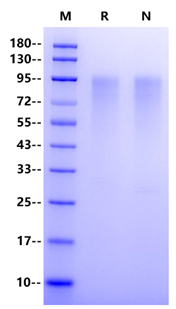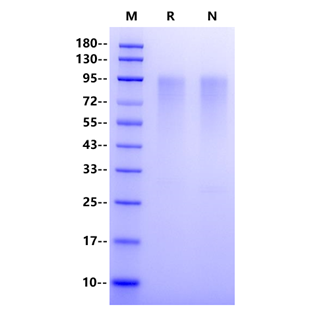1μg (R: reducing conditions, N: non-reducing conditions).
Product Details
Product Details
Product Specification
| Species | HRSV |
| Antigen | Glycoprotein G |
| Synonyms | HRSV Glycoprotein G, Glycoprotein GP55, Envelope glycoprotein B |
| Accession | P20895 |
| Amino Acid Sequence | His67-Gln298, with C-terminal 8*His HKVTLTTAIIQDATSQIKNTTPTYLTQDPQLGISFSNLSEITSQTTTILASTTPGVKSNLQPTTVKTKNTTTTQTQPSKPTTKQRQNKPPNKPNNDFHFEVFNFVPCSICSNNPTCWAICKRIPNKKPGKKTTTKPTKKPTFKTTKKDHKPQTTKPKEVPTTKPTEEPTINTTKTNIITTLLTNNTTGNPKLTSQMETFHSTSSEGNLSPSQVSTTSEHPSQPSSPPNTTRQGGGSHHHHHHHH |
| Expression System | HEK293 |
| Molecular Weight | 55-95kDa |
| Purity | >95% by SDS-PAGE |
| Endotoxin | <0.1EU/μg |
| Conjugation | Unconjugated |
| Tag | His Tag |
| Physical Appearance | Lyophilized Powder |
| Storage Buffer | PBS, pH7.4 |
| Reconstitution | Reconstitute at 0.1-1 mg/ml according to the size in ultrapure water after rapid centrifugation. |
| Stability & Storage | · 12 months from date of receipt, lyophilized powder stored at -20 to -80℃. · 3 months, -20 to -80℃ under sterile conditions after reconstitution. · 1 week, 2 to 8℃ under sterile conditions after reconstitution. · Please avoid repeated freeze-thaw cycles. |
| Reference |
1、Melero J A. et al. (1997) Antigenic structure, evolution and immunobiology of human respiratory syncytial virus attachment (G) protein. J Gen Virol. 78 (10): 2411-2418. 2、Trento A. (2006) Natural history of human respiratory syncytial virus inferred from phylogenetic analysis of the attachment (G) glycoprotein with a 60-nucleotide duplication. J Virol. 80(2): 975-984. |
Background
Human respiratory syncytial virus (HRSV) is a major cause of lower respiratory tract disease in babies and vulnerable adults. The viral genome, a negative-sense single-stranded RNA molecule, encodes at least 11 distinct proteins, two of which (G and F) are the major surface glycoproteins anchored in the viral membrane. The G glycoprotein is the attachment protein that mediates virus binding to cells. The F glycoprotein mediates fusion of the viral and cell membranes for virus entry into the cell and fusion of the infected cell membrane with that of adjacent cells to pro mote syncytia formatio A characteristic feature of HRSV is that moderate levels of antibody do not provide lasting protection, although prior infection can modulate the severity of the disease. HSRV is classified in the genus Pneumovirus, subfamily Pneumovirinae, family Paramyxoviridae. Other members of this genus include RSV of cattle, goats and sheep, and pneumonia virus of mice (PVM).
Picture
Picture
SDS-PAGE



